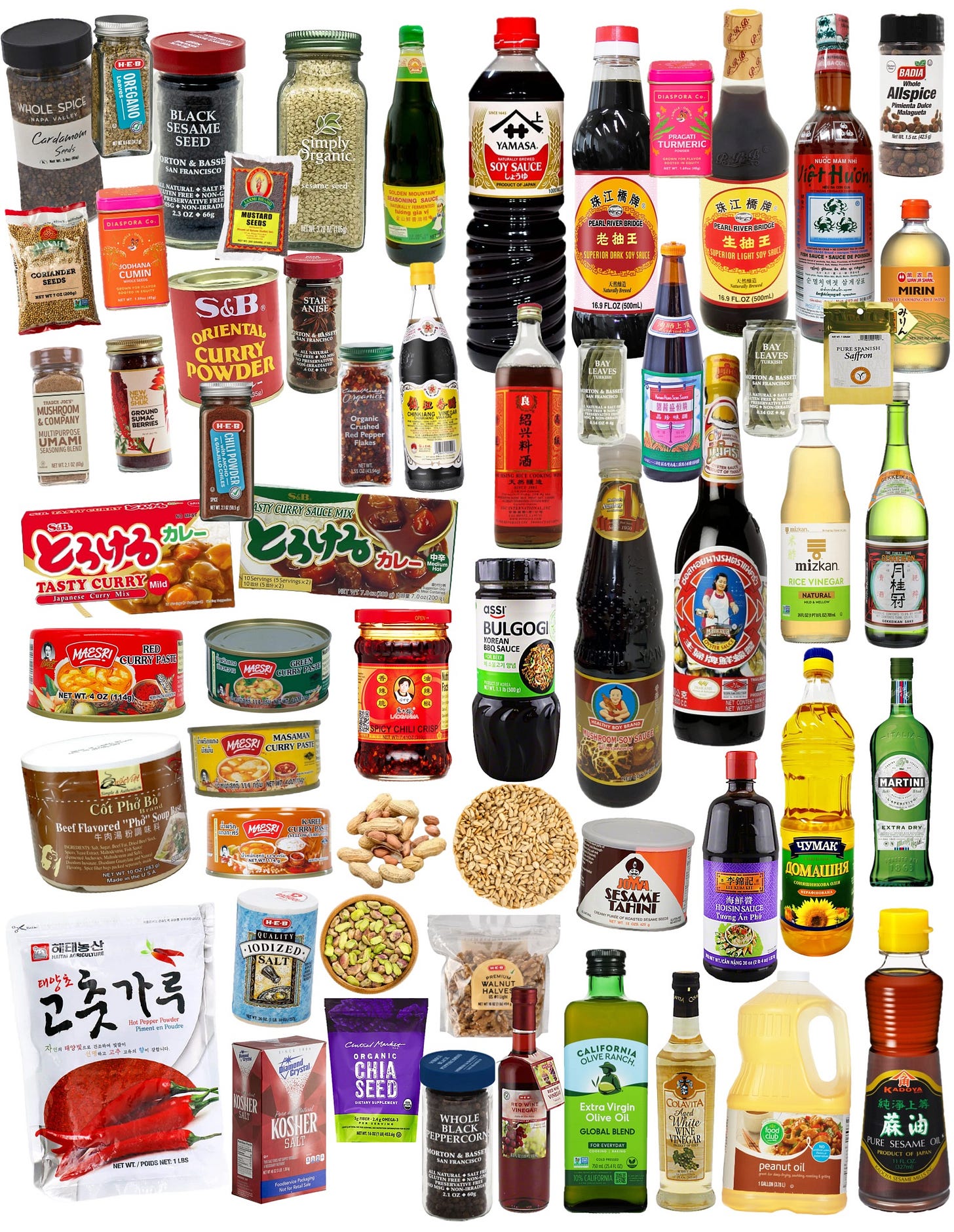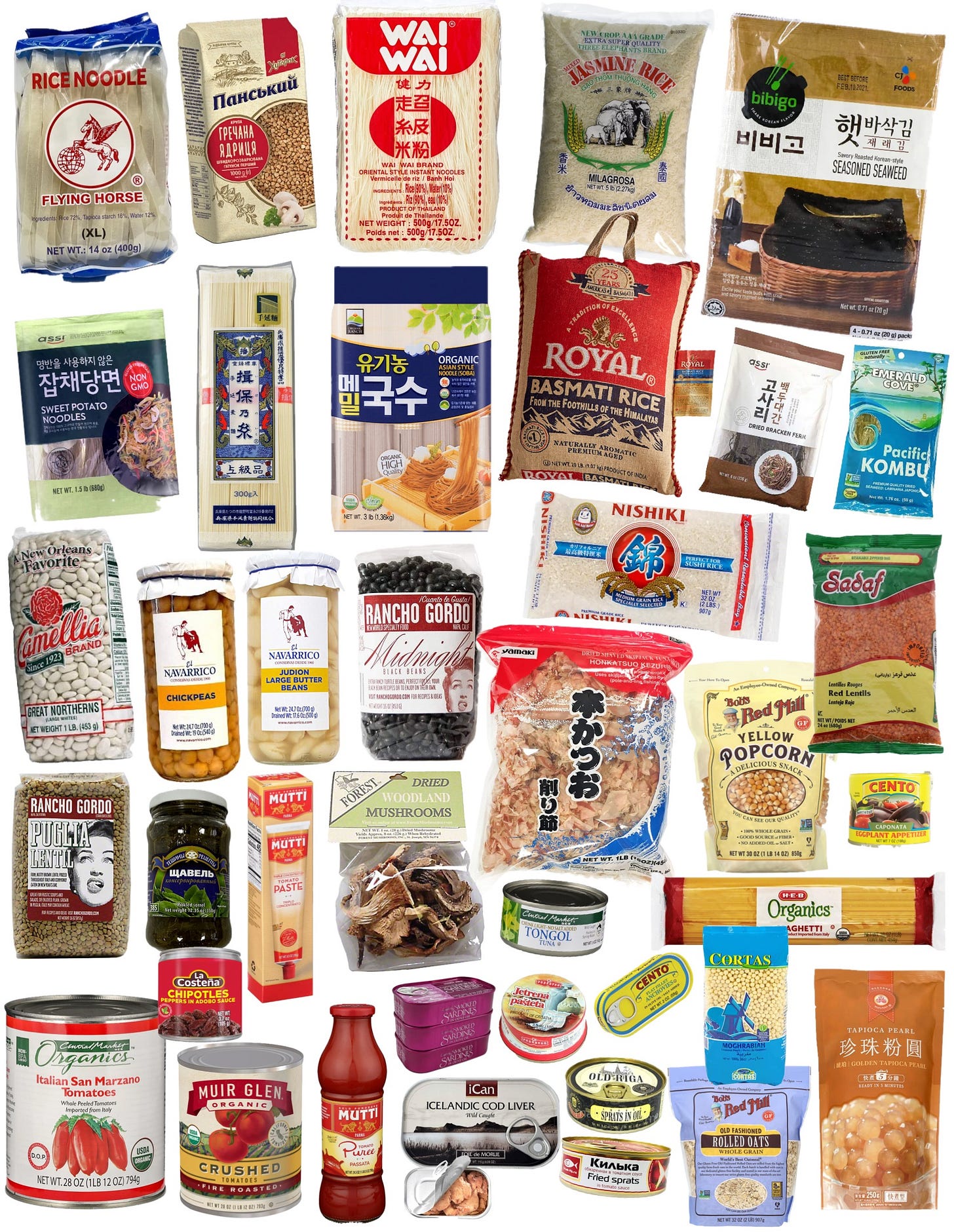M.U.V.K.I.S: My Unfussy Visual Kitchen Inventory System
A look inside my pantry and fridge
If you’re enjoying this newsletter, please consider becoming a paid subscriber. It’s only $30 a year. That’s like one shitty cookbook! Upon becoming a paid subscriber you will receive a copy of my digital Burnt Basque Cheesecake Cookbook Zine! Your funds will also go towards future zine publications as well as making sure that the vast majority of content is free for all.
For how much I cook and bake, you would think I would have zero issues keeping track of all my pantry items. Well, it has been a journey, let me quickly tell you about it.
It actually took me a bit of time to come up with a kitchen inventory system that worked for me, my brain, and my chaotic life.
The first thing I tried was excel/google sheets. I created a very organized (and very boring) spreadsheet of all my pantry items. It had the following columns; the name of the product; the quantities; the expiration date. This last one helped me prioritize items that needed to be used up first. I also added a color coding system to help me spot items that are running low or ingredients that are 86 (kitchen speak for being out) and in need of replacement.
Unfortunately, a couple weeks in, I found myself neglecting the spreadsheet—forgetting to constantly update the endless rows and columns. Furthermore, looking through rows of data left me feeling tired and uninspired. I felt no motivation to bake or cook after checking and reviewing the spreadsheet. I also developed a habit of getting easily distracted by tidying up and trying to enhance the spreadsheet instead of focusing on inventory management itself. Or, you know, cooking, recipe development, and writing.
I then tried moving the spreadsheet into Notion, a productivity and note-taking app. I promise this isn’t an advertisement. Although Notion is commonly used as a project and task management tool, I have been using it to help me manage my personal and professional life since 2016. Out of the dozens of things, this just clicks for me.
My favorite feature of the app is the ability to build endless databases within the app which means having all of your data in one place. How cool is that! I have a database for pitching and writing projects, various bibliographies, book lists, recipe development, etc. This kind of madness makes sense to me.
So now instead of just having a boring spreadsheet, I made a pantry database. Converting the spreadsheet into a database allowed me to add images to the database as well as change the layout of the database so I could see the items, the actual goods in hand, instead of just seeing their names in list view. You can seamlessly change how you view your database from gallery view to table view to board view you name it, Notion can do it all.
Unfortunately, I ran into the same issues. I found myself focusing on optimizing the database instead of using it to cook, write, plan meals, and develop recipes. I really struggled as my list grew and grew. I had to scroll A LOT. It did not matter what view I tried, I just had too much and I was doomed to scrolling as I kept trying to figure out how to categorize, catalogue, or condense my data into something I could use instead of futz with.
And then it finally dawned on me. What was actually missing was the ability to see all my ingredients in the same place (on the same page). Seems obvious, but I got stuck in these different programs, apps, and their endless options. Literally had to just think outside the box. I long for having a pantry door to open, seeing all my ingredients, so why not open a file and see everything? So in the end what I really needed was a visualization of all my pantry, fridge, and freezer items. That’s it.
I just needed to know what was in my cabinets, drawers, fridge, cellar, basement, kitchen, garage, porch (I’m learning many Ohio things!), and so on. As someone who doesn’t have an actual walk-in pantry (beyond a fond fantasy) the only way I could think creatively about the food itself is by looking at the ingredients as I do when shopping at grocery stores or farmers markets.
I get my best ideas and motivation when everything is out in plain sight. So how could I replicate that same experience without having the space to lay out all my ingredients in my space. This is where another app comes in. This time, I used Goodnotes, a notes management and note-taking app that I use to annotate pdfs, take handwritten notes using my iPencil on my iPad, and create collages of images I save and pull from the web, social media, my own photos, etc.
Do you need this specific app? No, you do not. If you have an iPhone you can use the Notes or the Freeform app to do the same thing. Copy the subject from whatever image you are using and paste it into the document. That’s it. Obviously, it takes a bit of time when you are just getting started but the long term rewards are so worth it. In the end you will have a visual representation of everything you have!
Let me show you what I have made so far. I obviously had to decide on some level of organization. So I came up with 7 main categories, today I want to share 4 of them with you all.
Baking Card
Sauces, Oils, Spices, and Nuts Card
Noodles, Legumes, and Canned Goods Card
Dairy, Ferments, and Condiments Card
Each category gets its own page or as I like to call them cards. These categories probably only make sense to me and you would probably organize or group things in ways that make sense to you and your brain. For me these four categories are broad enough so that I could see all the ingredients on one card related to that theme.
I’m still not completely sold on the categorization but this initial setup is already working much better for me.
So how do I use this? I look at it, I look at it often, and best of all, I love looking at it. Once I use up one of the ingredients, I copy and paste it onto a new page/card titled, NEEDS REPLACED. Once that’s done, I delete the item from the original card and I won’t add it back until it's replaced.
I have an hour blocked off every Sunday to do a quick scan of my kitchen and update the pantry cards and move whatever is out to the NEEDS REPLACED card and if I replace any of the other items throughout the week, I move them back to their home category card.
You can create however many cards/categories you want, a card for running low items, a card for expiring soon ingredients, etc. You can of course actually cross things out and annotate the cards if you so wish but personally I prefer to keep the cards text free, at least for now.
I will be sharing my remaining three cards in the upcoming weeks!
Freezer and Animal Protein Card
Veg and Fruit Card
Bread Baking Card
But here are the four cards I mentioned above.
#1 Baking Card:
#2 Sauces, Oils, Spices, and Nuts Card:
#3 Noodles, Legumes, and Canned Goods Card:
#4 Dairy, Ferments, and Condiments Card:
I’m super curious, how do you manage your pantry and kitchen? Do you have your own pantry management system? Do you use a food inventory app? Do you have a kitchen inventory of your pantry, fridge, and freezer? Let me know in the comments.






That’s a novel idea.
This is such a great idea. I have small pantry where you can *almost* see everything. I just went through it the other day to reorganize. Otherwise I try to keep everything in my head - always questioning...do I have that? I can either remember of completely forget about the item lol. meal prep or creating a general idea for weekly meals has been helping me use things I'd usually forget about though. I roughly look through the day prior to meal planning to determine what I can use up.